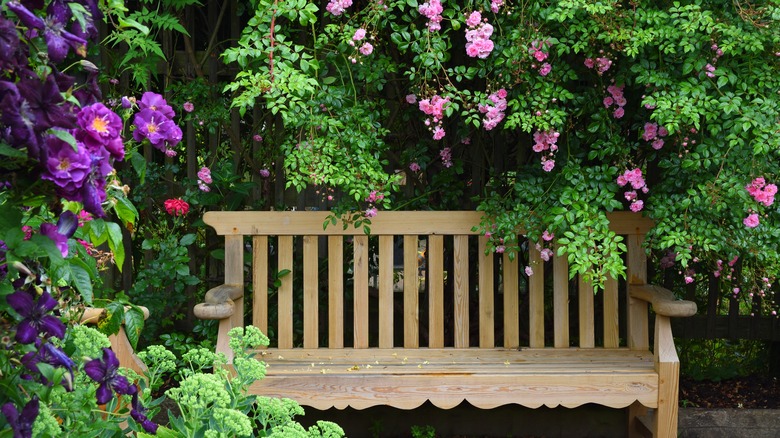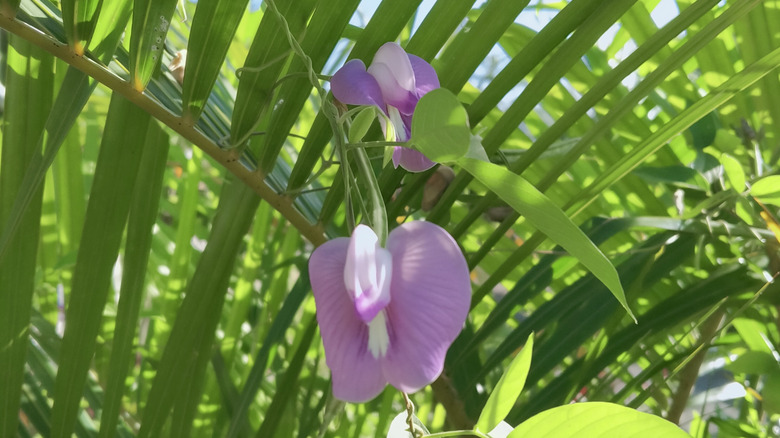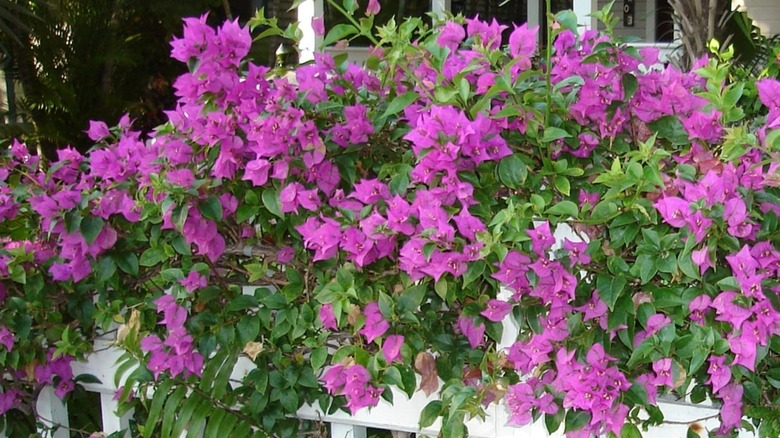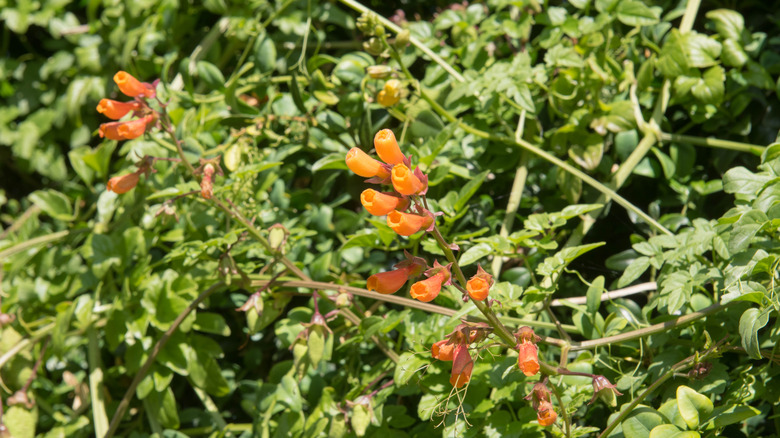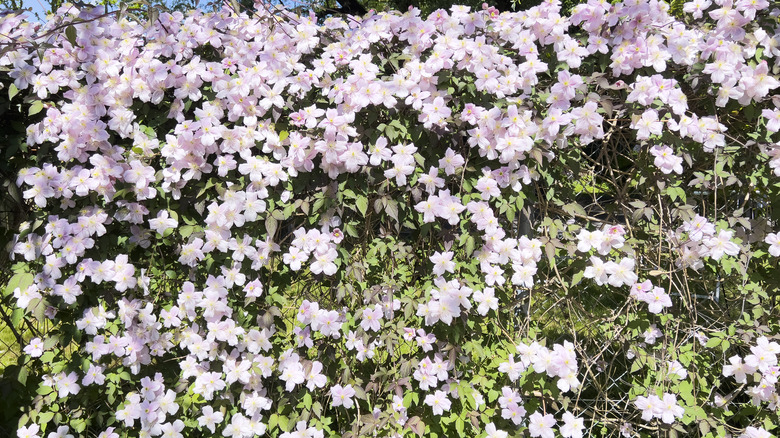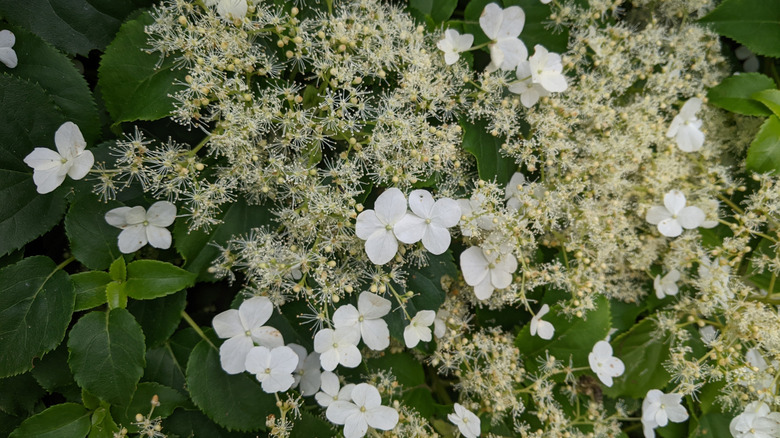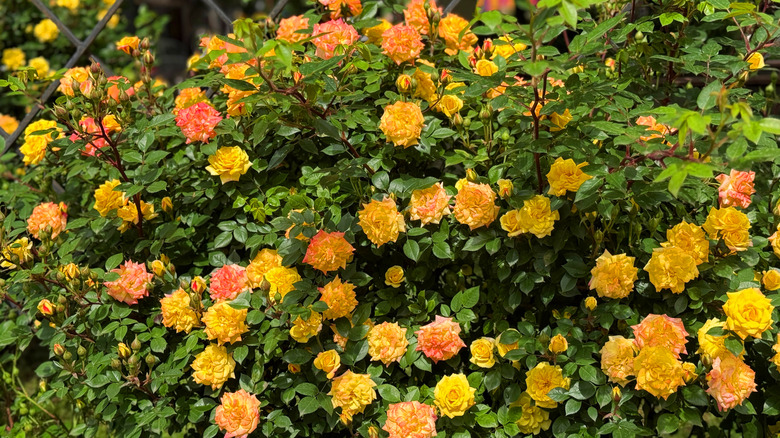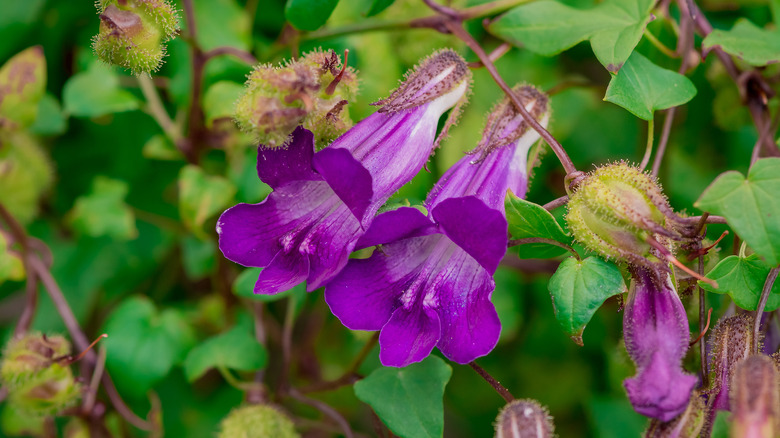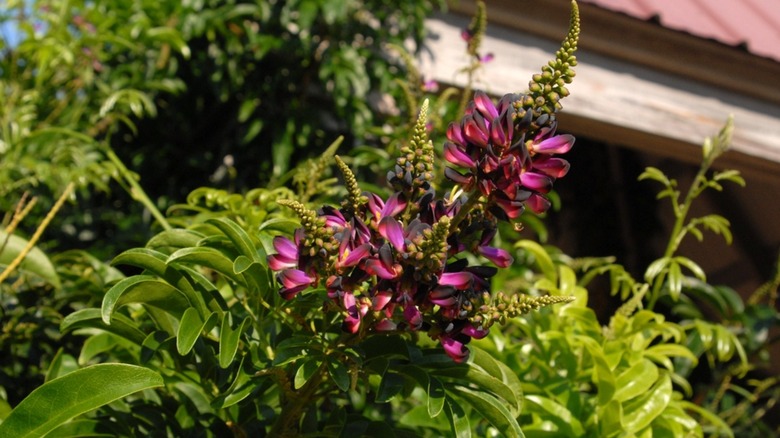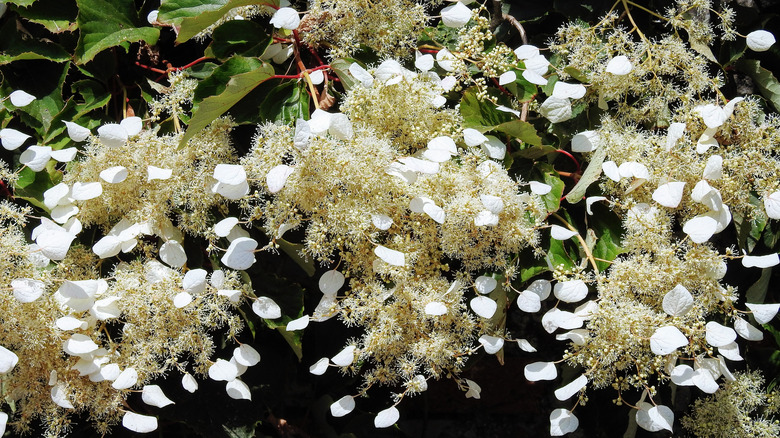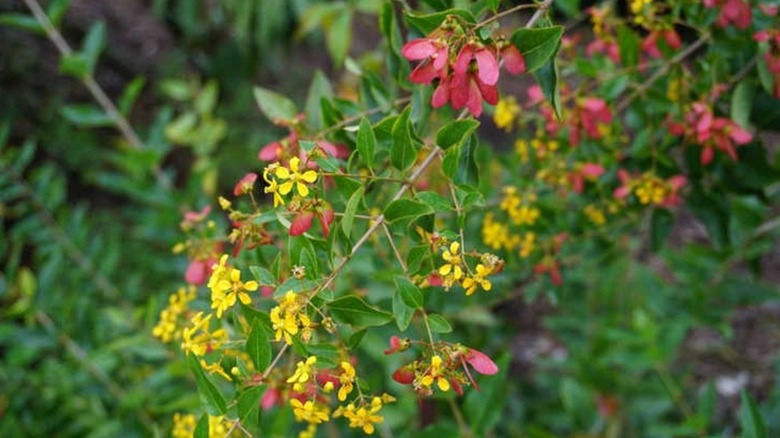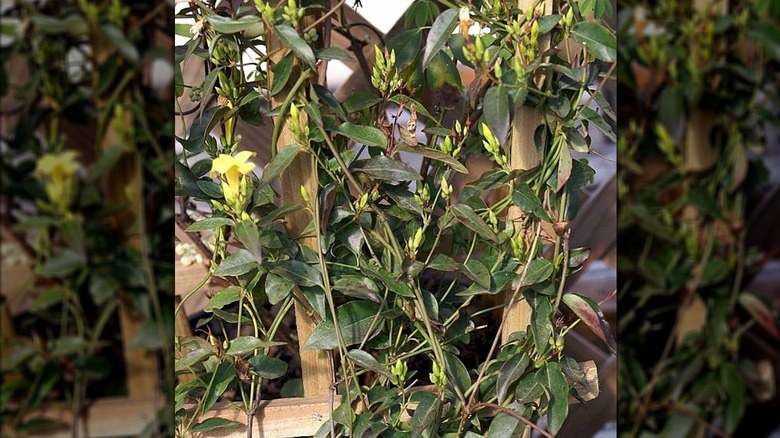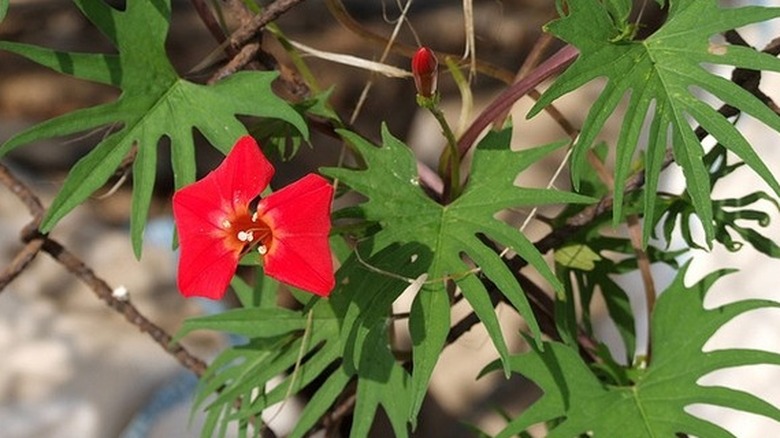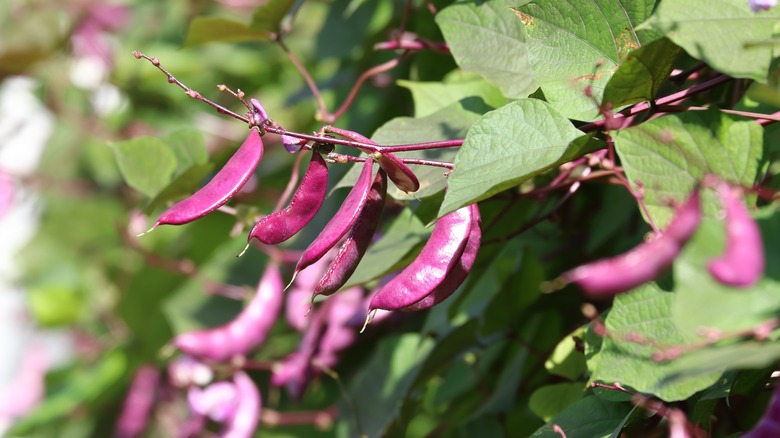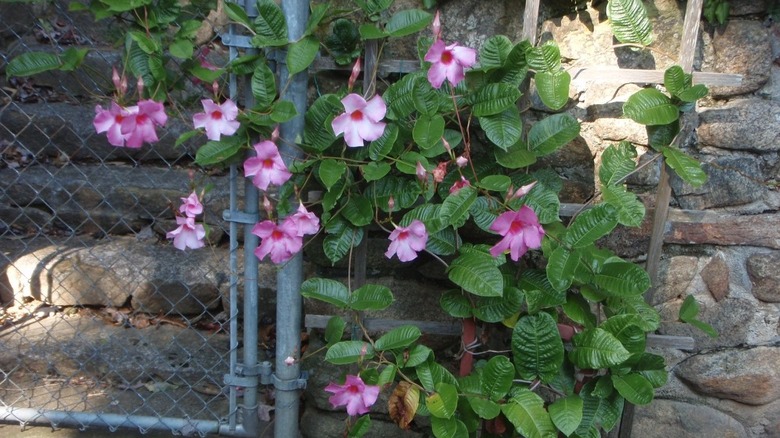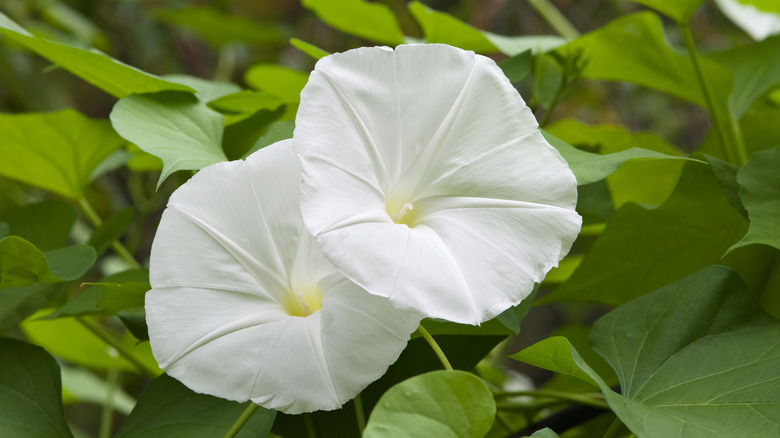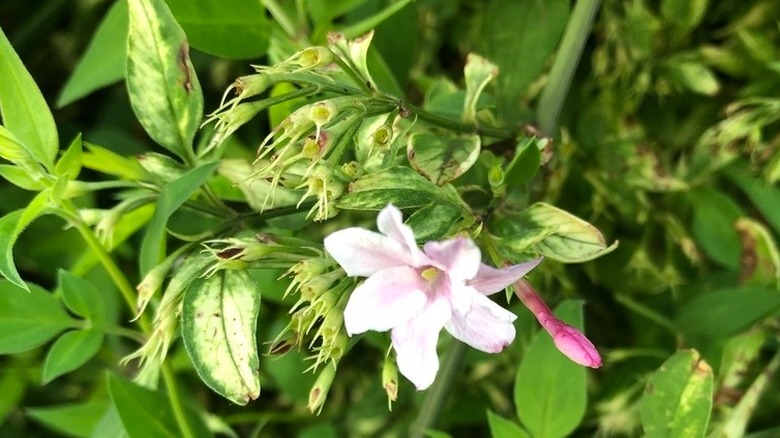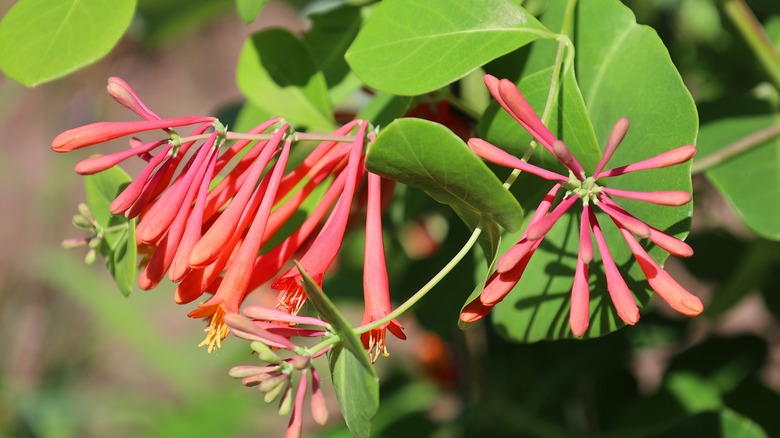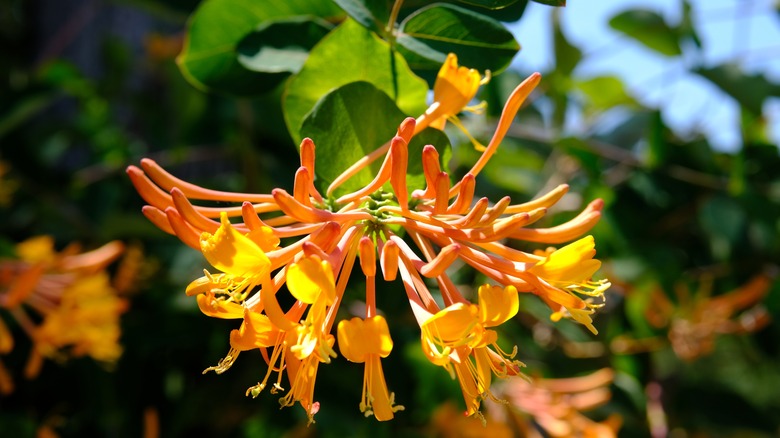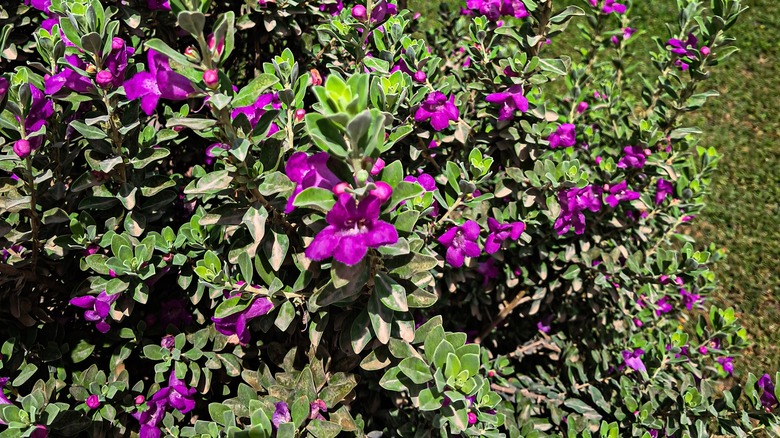21 Climbing Plants That'll Effortlessly Blanket Your Yard With Color
Are you tired of staring at blank walls, bare arches, and unsightly fences that add nothing to your landscape? Well, it's time to get some climbing plants. These natural climbers have evolved unique mechanisms, such as grabby tendrils or aerial rootlets, that allow them to ascend vertical surfaces with extraordinary ease. However, there's no dearth of scramblers — the plants that religiously produce long stems but rely on their growers to be merciful enough to give them support for climbing. What makes climbing plants particularly valuable to gardeners is that after they've scaled heights, they promptly turn mundane spaces into dramatic focal points. Through their abundant blooms and dense canopies, they inject seasonal color, vertical dimension, privacy, and shade into the landscape.
The cherry on top? There's so much variety that you're certain to find a colorful climber that not only enhances the visual aesthetic but may also accommodate your yard's unique challenges. Got poor soil? Get nitrogen-fixers, such as butterfly pea or hyacinth bean. Need to cover a shady spot? Climbing hydrangea and winter jasmine are some excellent options. Dealing with a hot spot that could use some shade? Clematis or swamp jasmine could tide you out. Now that you've got the drift, here's a quick discussion on 21 climbing plants to effortlessly blanket your yard in gorgeous color.
Butterfly pea
Native to the southeast U.S., butterfly pea (Centrosema virginianum) vines are one of the best climbing plants that will turn your backyard into a butterfly haven — skippers and cloudywings use their foliage for egg-laying. However, it's the bees that pollinate their purple blooms that make a show all summer. Eke out a space in a sunny site in your garden for a trellis to train this vine over it. As this perennial vine can fix nitrogen, prop the trellis around ornamentals that may benefit from this nutrient boost. Alternatively, use it on slopes to manage erosion. Zones 5 to 9 are ideal growth areas.
Bougainvillea
Instill a balmy feel in your yard with bougainvillea (Bougainvillea spp.). Although the vine's tiny flowers are stark white and don't do much on their own, they undeniably become showstoppers because of the papery bracts (modified leaves) surrounding them. These bracts come alive in magenta pink or white hues intermittently, rendering year-round interest. Bougainvillea is a scrambler and must be trained over a sturdy structure, or it'll simply crawl aimlessly. Perennial in zones 9b to 10b, it's grown as an annual elsewhere in the country in full sun sites. Bougainvillea can handle drought and heat. Keep an eye out for thorns.
Chilean glory flower
Enhance the visual appeal of your walkways, pools, patios, or gardens by training Chilean glory flower (Eccremocarpus scaber) over a trellis propped in these spots. From mid-summer through frost, this tender perennial will be laced in orangish-red blooms that hummingbirds find attractive. Although it tolerates light shade, it's ideal to plant in full sun sites for the best flowering. To maximize flowering, start the seeds indoors, especially in cool climates. Chilean glory flower is winter hardy only in zones 8 to 10, so you may want to save its cuttings for replanting next year.
Clematis
Hardy in zones 3 through 9, clematis (Clematis spp.) vines are some of the most popular climbing plants to grow over walls, porches, or trellises because their thick canopies offer ample shade and beauty. When using lattices for vertical support, look for thin weaves, or the vines may be unable to cling on properly. Most clematis varieties require six hours of sun exposure, unless it's an arid climate or the vine produces large blue, red, or multi-colored blooms that fade in intense heat. Keep their roots mulched or shaded with shallow-rooted groundcovers for optimum growth. Avoid growing clematis varieties that are invasive in your area.
Climbing hydrangea
In zones 4 to 8, consider warming up an existing privacy fence with climbing hydrangea (Hydrangea anomala). Or, if you'd like, allow this ornamental vine to sprawl over tree trunks, stumps, or stone walls. It'll easily hold on to these structures with its aerial rootlets. In early summer, expect the vine to produce sweet-smelling, creamy white flowers, while the green foliage and peeling bark render ornate interest during other times. Climbing hydrangea is a shade lover, though it may tolerate full sun in cool climates if the soil is kept consistently moist.
Climbing rose
As you may know, roses (Rosa spp.) are available in a wide range of growth habits, including climbers and ramblers. From English roses and hybrid tea to Noisette and Bourbon, there are plenty of climbing rose varieties to choose from. Better yet, most of them rebloom if deadheaded timely. However, bear in mind that climbing roses don't have the implements to naturally attach to a surface. Instead, you must tie them to a vertical structure and keep training and pruning for the desired form. Roses grow best in full sun and are hardy in zones 5 to 11.
Cup and saucer vine
Popular with hummingbirds, bees, and butterflies for its bell-shaped, purple flowers that add much-needed color during the summer-fall transition, cup and saucer vine (Cobaea scandens) rightfully deserves a spot in any pollinator garden. Support the vine over an arbor, fence, or a trellis that's exposed to direct sunlight for the greater part of the day. Moist, slightly acidic to neutral soils are preferred. Save for zones 9 to 11, where these vines are perennial, they're grown as annuals everywhere else, which limits their mature size to about 20 feet. Monitor their growth for mites and aphids.
Evergreen wisteria
Despite its name, evergreen wisteria (Callerya reticulata, formerly Millettia reticulata) is not technically a wisteria vine; rather, it's a look-alike. Around summer, this non-invasive vine is covered in wisteria-esque, pea-shaped, mauve flowers that infuse the air with a cedar-like aroma. With diligent deadheading, you can prolong the show into autumn. Evergreen wisteria has a twining habit and will easily climb up fences and trellises. However, you must prune it regularly for size containment since it can grow nearly 30 feet, as well as to promote lower shoot growth as that area grows bare over time. It's cold-hardy in zones 8 through 11.
'Moonlight' Japanese hydrangea vine
Technically, 'Moonlight' Japanese hydrangea vine (Schizophragma hydrangeoides 'Moonlight') is not a true hydrangea, but it's named so after its summer-blooming white flowers that resemble lacecap hydrangeas. 'Moonlight' kicks up the color contrast further through its silvery-gray, heart-like foliage and rust-colored stems that keep winters interesting. Since these vines develop holdfasts, you can grow them over masonry walls or other free-standing hard structures. However, note that 'Moonlight' isn't for the impatient, as it can take up to seven years after transplantation to begin flowering. From full sun to heavy shade, it tolerates diverse light conditions in zones 5 to 8.
Redwing
Ratchet up the summer heat in your yard with redwing (Heteropterys glabra) that produces a fiery combination of gold blooms and red fruits near-simultaneously. Planted in full sun, this woody vine can continue this display through the fall in zones 7 to 10. Redwing's foliage is equally showy, emerging as burgundy and slowly transforming into luscious green, creating a beautiful effect. If you aren't too keen on propping trellises, you can grow this plant underneath shrubs or trees, where the vine will eventually intertwine through their limbs. It likes moist soils but shows tolerance to occasional droughts.
Swamp jasmine
Swamp jasmine (Gelsemium rankinii) is the lesser-known yellow flowering vine that's similar to Carolina jessamine and blooms twice a year, in spring and fall. It outshines its counterpart in flood tolerance, as it can tolerate waterlogged areas for longer and has a natural preference for wet and boggy soils. Since it grows fast, you may utilize this vine to establish a quick, evergreen screen by bracing it over trellises or shade structures. It also hangs well on chain-link fences and can deter deer. Swamp jasmine is hardy in zones 7 to 9, but site it carefully because it's highly toxic if ingested.
Hearts and honey vine
An heirloom variety of morning glory, hearts and honey vine (Ipomoea x multifida) is a frost-tender vine that's mostly grown as an annual, except in zones 10 to 12, where it's reliably hardy and frequently self-seeds. Despite being a hybrid, this vine produces viable seeds that clone the parent plant, so be sure to save a few seeds for next year. In the summer, their emerald green, palmate leaves are interspersed with waves of yellow-throated, red flowers that draw in hummingbirds and butterflies. However, avoid growing it if deer tend to frequent your area, as they'll likely devour its foliage.
Hyacinth bean
Lovers of purple will find hyacinth bean (Lablab purpureus) an excellent addition to their yards. This twining vine, which can reach 25 feet high when given such a support, produces purplish stems that get topped by pinkish-purple flowers in the summer and fall. Some varieties also produce lavender fruit pods, though the seeds can be toxic if consumed in substantial quantities. Another benefit? Hyacinth bean can fix nitrogen and improve your yard's soil quality, especially if you allow its dead leaves to decompose. Since it tolerates heat and humidity, it grows well year-round in hot climates, but is an annual vine in zones 9 and colder.
Mandevilla
A Brazilian introduction, mandevilla (Mandevilla spp.) is a tropical vine that can deal with extreme heat without breaking a sweat. It marks summers by blooming large, five-lobed flowers that can be pink, red, yellow, or purple, depending on the cultivar. However, be careful with your selection as newer varieties have a more shrubby form. Try to source options like 'Alice Dupont' or 'Red Velvet' to deck trellises, but if you're looking for something more compact to go over mailboxes or in containers (with stake support), consider offerings from the Sun Parasol series. Give them full sun and well-draining soil.
Moonflower
If you're creating a moon garden, you just can't skip over moonflower (Ipomoea alba). In mid-summer, when the sunrays have dimmed for the day, huge, white blooms open up and remain so throughout the night, so pretty moths can pollinate them. Expect to enjoy their sweet fragrance well into fall until the cold temperatures kill the vines. Even when not in bloom, moonflowers look gorgeous thanks to their massive, fleshy, heart-shaped foliage. Stake the vines over a vertical support where they receive plenty of sunlight. If you're growing them in containers, you can bring them indoors during winter to avoid dieback.
Spanish flag
Want your yard to become the talk of the neighborhood? Try Spanish flag (Ipomoea lobata) or firecracker vine. Unlike most plants, this Mexican native produces whorls of petals along a curved stem, which show the same red and yellow colors concurrently as the Spanish flag. Hummingbirds and butterflies naturally herd around these blooms that appear in near-constant waves all summer through fall when this vine is frost-killed (it may return in spring in frost-free areas of zones 9 to 11). Per usual, you'll need to support the vines over a trellis for them to successfully clamber up.
Stephen jasmine
Use Stephen jasmine (Jasminum x stephanense) to create a blushing garden because it's draped in light pink blooms during summers. Since these flowers are highly aromatic and call forth hummingbirds and butterflies, locate the vines so you may get their front view when these pollinators are in action, say near a patio or entryways. Although hardy in zones 7 to 10, their foliage may die during the winter up north, greening up come spring. One way forward is to plant them in containers and move indoors during the coldest temperatures. Star jasmine prefers rich, fertile soils and full-to-part sun exposure.
Trumpet honeysuckle
If you live in the southeastern U.S., consider growing trumpet honeysuckle (Lonicera sempervirens). This native plant is important for a sustainable approach to attracting hummingbirds to your yard. Ruby-throated hummingbirds sip their nectar when the yellow-marked, scarlet flowers are in bloom during spring and summer. Various butterflies and moths use their foliage for egg-laying, while birds seek their red berries. As you can imagine, having them climb over arbors or fences can instantly transform your place into a pollinator magnet. Grow these deer-resistant vines in organically rich soils with full sun exposure. They're hardy in zones 4 to 9.
Winter jasmine
With winter jasmine (Jasminum nudiflorum), you can inject a bolt of brightness into your otherwise drab and dreary wintry landscape. This trailing vine kickstarts the new year with clouds of yellow blooms that smother the bare stems. After flowering, it retains its appeal through green foliage. Winter jasmine likes plenty of sun, but if you're looking to cover any shaded walls, terrace, or arbor, it will survive but won't produce as many flowers. It's a fast grower, and with deer showing little appetite for its leaves, it can grow over 10 feet. You may successfully grow it in zones 6 to 10.
Yellow honeysuckle
If you've the space to accommodate at least two climbers, give yellow honeysuckle (Lonicera flava) a chance. Planted in pairs, these vines produce reddish-orange berries that many birds look forward to during summer and fall. As if that view wasn't enough, you'll find butterflies and hummingbirds collecting around the whorls of yellow blooms as they unfurl in the spring. Yellow honeysuckle is native to the southeast U.S., but is reliably hardy in zones 5 to 8. Since their foliage fills out nicely and doesn't cater to deer, you may train it over a trellis for privacy or a security barrier.
Snapdragon vine
Since snapdragon vine (Maurandella antirrhiniflora) is diminutive in size, usually terminating at around 5 feet, it's best used to cover small gates or lattices. Although not a true snapdragon, this deer-resistant vine produces similar flowers. In short, white throated, reddish-purple blooms with pink nectar lines to guide pollinators along. If your area falls in the range of common buckeye butterflies, they'll thank you for these vines, as their caterpillars love their leathery leaves. Except for zones 9 and 10, snapdragon vines will suffer winter dieback across the country. Site them in full sun for maximum flower production.
